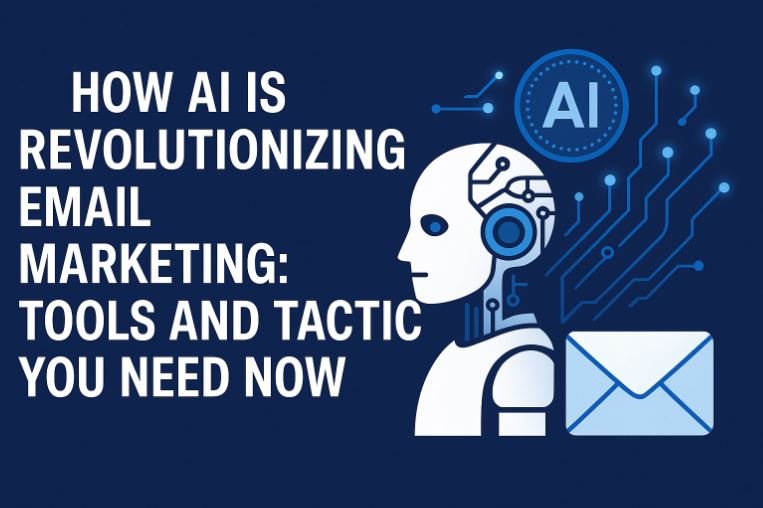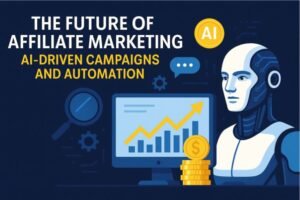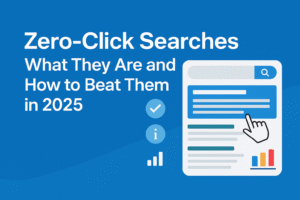Why Email Marketing Needs AI Now More Than Ever
Email marketing has been around for decades. But let’s face it—sending one-size-fits-all messages and hoping someone opens them just doesn’t cut it anymore. Consumers expect personalization, smart recommendations, and timely content. That’s where AI (Artificial Intelligence) steps in.
How AI is Revolutionizing Email Marketing: Tools and Tactics You Need Now is more than just a buzzworthy topic. It’s the reality reshaping how brands connect with subscribers—turning outdated newsletters into dynamic, data-driven campaigns that convert.
If you’re a marketer, business owner, or digital creator, understanding the AI-powered shift isn’t optional. It’s essential.
What Is AI in Email Marketing?
AI in email marketing refers to using machine learning algorithms and automation tools to optimize every stage of your email strategy—from segmentation and subject lines to send times and personalized content.
Let’s break it down:
| AI Feature | Function | Impact |
|---|---|---|
| Predictive Analytics | Anticipates customer behavior | Higher open and click-through rates |
| Natural Language Processing (NLP) | Creates personalized email content | More engaging email copy |
| Smart Segmentation | Groups users based on behavior and preferences | Improved targeting |
| Automated Testing | Runs A/B tests and optimizes campaigns | Better campaign performance |
| Optimal Send Times | Chooses best times to send emails | Increased engagement and fewer unsubscribes |
The Old vs. New: Traditional Email Marketing vs. AI-Driven Campaigns
| Aspect | Traditional Email Marketing | AI-Driven Email Marketing |
|---|---|---|
| Content Creation | Manual and static | Auto-generated, dynamic, and contextual |
| Audience Targeting | Basic demographics | Behavior-based, psychographic, real-time |
| A/B Testing | Manual and slow | Automated and ongoing |
| Send Time Optimization | General time slots | Individualized per recipient |
| Analytics | Post-campaign reports | Real-time performance insights |
Example:
In the past, a clothing brand might send the same “Winter Sale” email to 10,000 subscribers. Today, with AI, each recipient sees winter jackets or boots based on their browsing behavior, purchase history, and even local weather. That’s personalization done right.
Top 7 AI Tools for Email Marketing in 2025
Here are the most effective tools disrupting the email marketing landscape in 2025:
1. Seventh Sense – Behavioral Send Time Optimization
Optimizes email delivery based on recipient behavior patterns.
Best for: B2B newsletters, SaaS email campaigns
2. Phrasee – AI-Powered Subject Lines and Copy
Uses NLP to generate and test subject lines that resonate.
Best for: High-volume senders, eCommerce
3. Optimail – Adaptive Email Personalization
Adapts content blocks in real-time for each recipient.
Best for: Content-rich brands like media or education
4. Rasa.io – Personalized Newsletter Automation
Automatically curates and sends personalized content.
Best for: Thought leaders, news aggregators
5. Mailchimp + AI Recommendations
Offers AI-powered product recommendations and behavioral triggers.
Best for: SMBs and DTC brands
6. Salesforce Marketing Cloud Einstein
Predictive scoring, customer journey mapping, and smart segmentation.
Best for: Enterprise-level campaigns
7. ActiveCampaign
Combines CRM, AI, and marketing automation.
Best for: Businesses needing sales + marketing alignment
| Tool | Key Feature | Ideal For |
|---|---|---|
| Seventh Sense | Send-time optimization | B2B, SaaS |
| Phrasee | NLP-powered subject lines | eCommerce |
| Optimail | Adaptive content | Media, Educators |
| Rasa.io | Smart curation | Bloggers, Journalists |
| Mailchimp AI | Product recommendations | DTC, SMBs |
| Einstein (Salesforce) | Predictive customer journeys | Enterprise |
| ActiveCampaign | CRM + AI | Sales-driven teams |
Tactics You Need Now to Maximize AI in Email Marketing
1. Use Predictive Analytics to Nurture Leads
AI can predict which leads are more likely to convert and when. This means you can send hyper-targeted content just when it matters.
Try This: Use ActiveCampaign’s predictive scoring to trigger content flows based on lead behavior.
2. Auto-Segment Your List for Micro-Targeting
- Forget generic segments like age or location. AI lets you create dynamic segments like:
- Cart abandoners who viewed product X
- Readers who always click on health-related content
- Users active only on weekends
Pro Tip: Integrate your CRM with tools like Salesforce Einstein to segment in real time.
3. Let AI Write and A/B Test Your Subject Lines
Tools like Phrasee analyze past data and generate subject lines that statistically drive more opens. They even learn what tones and emojis your audience prefers.
Example:
Instead of guessing “ 30% Off Today Only!”, Phrasee might suggest:
→ “ A Little Something Just for You (You’ll Love It!)”
4. Hyper-Personalize Email Content at Scale
Dynamic content powered by AI pulls in user behavior, preferences, past purchases, and even the weather to create personalized email experiences.
Use Case:
A travel site might send “Warm Getaways” to users in cold climates and “Weekend Road Trips” to those in sunny areas.
5. Optimize Send Times Automatically
With tools like Seventh Sense, AI predicts the optimal time for each subscriber based on their past open habits. This boosts engagement without guesswork.
6. Automate Lifecycle Campaigns
- Set up AI-powered workflows that change based on recipient behavior.
- Welcome sequences that adjust based on click activity
- Reactivation campaigns for inactive users
- Upsell emails timed to purchase behavior
7. Leverage AI-Powered Analytics for Smarter Decisions
- Instead of reading long reports, AI surfaces key insights:
- Which content resonates most?
- Who is ready to buy?
- What type of CTAs convert best?
Tool to Try: Mailchimp’s “Smart Recommendations” feature.
Real-World Examples of Brands Using AI in Email Marketing
Amazon
Personalizes every single email—from product recommendations to delivery updates—using AI trained on user behavior.
MyFitnessPal
Uses AI to send habit-triggered emails based on users’ logged meals, workouts, and goals.
Booking.com
Adapts deals and emails based on search history, location, and device type.
The Future of AI in Email Marketing: What to Expect in 2026 and Beyond
Hyper-Contextual Emails: Emails generated entirely by AI, unique to each recipient.
Voice-Activated Emails: Integration with smart assistants like Alexa or Google Assistant.
Emotional AI: Emails that adapt based on user mood, inferred through interaction data.
Pros and Cons of AI in Email Marketing
| Pros | Cons |
|---|---|
| Saves time and effort | Initial setup complexity |
| Improves personalization | Risk of over-automation |
| Boosts open and click rates | Requires reliable data sources |
| Enhances segmentation and timing | May lack human creativity nuance |
Should You Embrace AI in Your Email Strategy?
Absolutely. Whether you’re running a solo newsletter or leading a marketing team, AI is not a luxury—it’s a necessity. The brands already leveraging AI are miles ahead in engagement, conversions, and customer retention.
This isn’t about replacing the human touch; it’s about enhancing it. AI handles the heavy lifting—freeing you to focus on creativity and connection.
Are you using AI in your email marketing yet? Share your favorite tools in the comments!
Want more smart marketing tips? Subscribe to our newsletter and get weekly AI-powered insights straight to your inbox!
Don’t miss our next article on “AI-Powered CRM Tools You Need in 2025.”




